« April 2008 | Main | June 2008 »
May 31, 2008
Northern Alberta & Northwest Territories
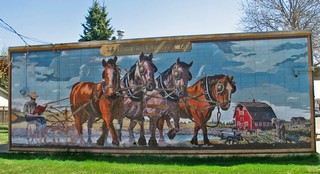 Head straight north of Edmonton on Hwy 2 for less than an hour and you can take a little side trip to the town of Legal (a Francophone community pronounced “Lee-GAL”). The town is filled with numerous excellent murals and we spent close to an hour walking around looking at them.
Head straight north of Edmonton on Hwy 2 for less than an hour and you can take a little side trip to the town of Legal (a Francophone community pronounced “Lee-GAL”). The town is filled with numerous excellent murals and we spent close to an hour walking around looking at them.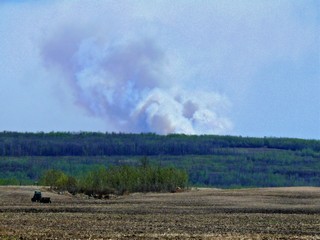
As we continued north toward Athabasca, we could see a massive cloud of smoke to the east. That night on the news and for the next few days we heard about a massive forest fire that had one town evacuated and two homes destroyed.
The whole land was dry and a total fire ban in effect.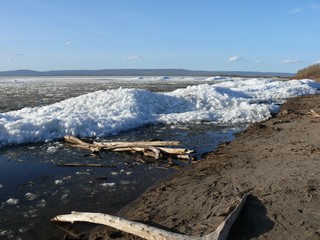
When we arrived in the town of Slave Lake, which is on the south shore of Lesser Slave Lake, we were surprised to see that the lake was still filled with ice – not frozen solid – but ice that moved, and gurgled and shifted and slowly eased east into the Lesser Slave River. The wind had piled it up along the eastern shore of the lake, while the west end of the lake was open.
Leaving Slave Lake 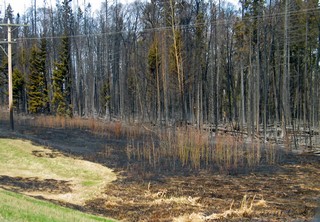 the next morning, May 17th, we travelled Hwy #2 past an area that was still smoldering and fire crews were still in attendance. This part of the road had been closed 2 days before and the campground had been given notice they might have to evacuate. Fortunately the fire was brought under control before that happened. Look closely and you can see the burn on the base of the telephone pole.
the next morning, May 17th, we travelled Hwy #2 past an area that was still smoldering and fire crews were still in attendance. This part of the road had been closed 2 days before and the campground had been given notice they might have to evacuate. Fortunately the fire was brought under control before that happened. Look closely and you can see the burn on the base of the telephone pole.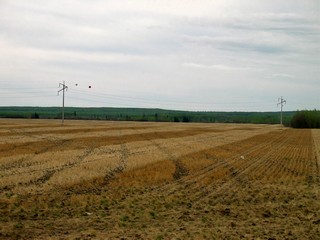 Continuing west and north we passed through High Prairie, stopped overnight in Peace River and then followed Hwy 35 to High Level, AB. This is a vibrant town on the northern edge of the prairies. We learned there are about 600,000 acres of land under cultivation in the area and another 20,000 acres of range land. Both of us were very surprised, as we had no idea that there was so much agriculture so far north. We are almost 800 km (500 miles) north of Edmonton by road.
Continuing west and north we passed through High Prairie, stopped overnight in Peace River and then followed Hwy 35 to High Level, AB. This is a vibrant town on the northern edge of the prairies. We learned there are about 600,000 acres of land under cultivation in the area and another 20,000 acres of range land. Both of us were very surprised, as we had no idea that there was so much agriculture so far north. We are almost 800 km (500 miles) north of Edmonton by road.
We camped at a great, little known campground at Fox Haven Golf Course just north of town and stayed 2 nights, planning on playing golf – but it rained. Instead, we took a side trip to Fort Vermilion. It was the Monday of the May holiday weekend so everything was closed and what we saw didn’t inspire us. We didn’t think it was worth the 150 km round trip.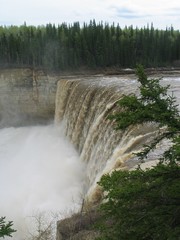
Very shortly after leaving High Level the cultivated land disappeared and was replaced with miles and miles of spruce, aspen and beaver lodges.
We crossed the 60th parallel into the Northwest Territories and continued to Hay River on the south shore of Great Slave Lake. Before reaching there, two scenic waterfalls are right beside the highway. Alexandra and Louise drop 108 ft. and 50 ft. respectively. They are on the Hay river which is almost brown – it’s not really dirty, the water just has a brown tone to it.
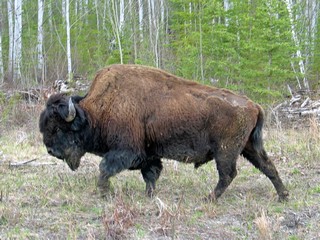 It’s around 276 km south and east to Fort Smith and about 140 km of that is gravel road (as it crosses Wood Buffalo National Park). The truck and trailer got dirty! We stayed at the Territorial Campground in Fort Smith and then travelled in to the Park with only the truck. The Park is the largest in North America, covering about 44,807 sq km (17,300 sq mi). It was created in 1922 to protect one of the worlds largest free-roaming heard of wood bison. It is now home to about 4,300 bison and is also the northern nesting grounds of the endangered whooping crane.
It’s around 276 km south and east to Fort Smith and about 140 km of that is gravel road (as it crosses Wood Buffalo National Park). The truck and trailer got dirty! We stayed at the Territorial Campground in Fort Smith and then travelled in to the Park with only the truck. The Park is the largest in North America, covering about 44,807 sq km (17,300 sq mi). It was created in 1922 to protect one of the worlds largest free-roaming heard of wood bison. It is now home to about 4,300 bison and is also the northern nesting grounds of the endangered whooping crane.
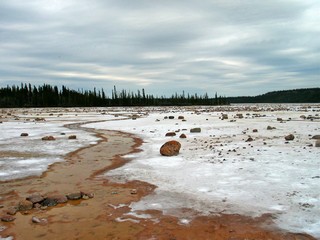 We spent one day sightseeing and hiking in the Park and were quite disappointed that we saw very little wildlife. The Whooping Cranes nesting grounds are inaccessible shallow lakes and marshes and the bison have such a huge area, that they seldom come to the single summer road that runs part way in. We only saw about 25 bison in total and 2 pair of swans.
One unusual feature is the Salt Plains, with bolders strewn all over. We reached it after about a 2 km hike through the woods. The white colour is salt, not snow and it looked like something out of science fiction.
We spent one day sightseeing and hiking in the Park and were quite disappointed that we saw very little wildlife. The Whooping Cranes nesting grounds are inaccessible shallow lakes and marshes and the bison have such a huge area, that they seldom come to the single summer road that runs part way in. We only saw about 25 bison in total and 2 pair of swans.
One unusual feature is the Salt Plains, with bolders strewn all over. We reached it after about a 2 km hike through the woods. The white colour is salt, not snow and it looked like something out of science fiction.The weather was generally good. It reached 10C to 12C during the day, got down close to freezing at night and we had mainly sunny days. The locals told us that is quite cool but one of the advantages is that we had very few mosquitos.
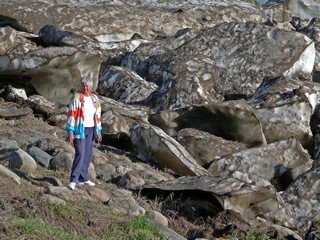 Yellowknife, the capital was next on the agenda. It’s 750 km so we took two days to travel that distance.
Yellowknife, the capital was next on the agenda. It’s 750 km so we took two days to travel that distance.
The Mackenzie River is crossed at Fort Providence, by a free ferry, although there is construction under way to build a bridge. The river was still full of ice flows and the ferry just churned through them. We camped right beside the river and were amazed at the size of the chunks of ice that had piled on the shore line. Of course by this time of the year they are quite dirty.
The roads have been okay although as in every northern community in the spring there are some problems. Road heaves are much more a problem than pot-holes. Unfortunately, they are hard to see until you are right on them and they give you quite a ride.
The land has been basically flat and tree covered, with a mixture of spruce and aspen, since just north of High Level, AB. Actually, the drive itself is quite easy but boring, as there is nothing to see. When we were about 100 km from Yellowknife, as we turned south east, having gone around the North Arm of Great Slave Lake, we quite suddenly were into granite. This is the Precambrian shield, the same land formation that dips down into Ontario, in the Muskoka district, some 3,500 km away.
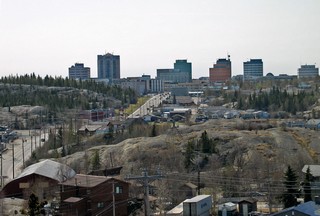 Yellowknife is a modern city of approx. 20,00 which comprises close to half the population of the NWT. Although the Dene hunted in the region for thousands of years, it was permanently settled when gold was discovered in 1934. It is built around lakes and on and around rock outcroppings. All the services you could want are here.
Yellowknife is a modern city of approx. 20,00 which comprises close to half the population of the NWT. Although the Dene hunted in the region for thousands of years, it was permanently settled when gold was discovered in 1934. It is built around lakes and on and around rock outcroppings. All the services you could want are here.
Diamonds were discovered in the NWT in1991 and that’s what is driving it’s current growth. The three mines headquartered here produce about 15% of the world’s diamonds by value. We visited the Diamond Visitors’ Centre to learn about this new industry.
Again we stayed at a Territorial Park. We have not seen any private campgrounds, but the Territorial ones are really quite good and we have had no problem getting in to them. Most of them offer 15 amp electrical hook-ups only, but that is fine as we carry water on board and each one has a tap where we can replenish our supply. They all also have a dump station that we use as required.
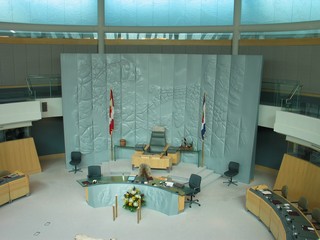 Our visit to the Legislature building, which opened in Nov. 1993, brought out an interesting fact about this Territorial government. The NWT is government by consensus – they have no political parties and because of this the 19 house seats are placed in a circle in the Chamber.
Our visit to the Legislature building, which opened in Nov. 1993, brought out an interesting fact about this Territorial government. The NWT is government by consensus – they have no political parties and because of this the 19 house seats are placed in a circle in the Chamber.
The outside of the building is clad in zinc, a northern mineral, and the interior walls are blonde maple wood. Skylights are everywhere so give it an abundance of natural light. To emphasize the openness of the government, the Members can be seen through glass doors opening from the Great Hall as well as from the Public Galleries.
Our plan was to leave Yellowknife and after the return crossing of the Mackenzie River, to follow the Liard Trail approx. 620 km west and south, to join up with the Alaska Highway just north of Fort Nelson, B.C. The 480 km of the Liard Trail in the NWT is gravel. On checking the NWT road conditions we learned that the section between Fort Liard and Fort Simpson was closed to all but light traffic. The RCMP in Yellowknife contacted the detachment in Fort Simpson for us, and we were advised to not even consider travelling that way. Two days later, the road was closed indefinitely for major repairs due to wash-outs from heavy rain. So, a change of plans. Instead of 2 days and 620 km to the Alaska Highway, we were looking at 5 days and 1350 km to the same point. That’s an additional 730 km at 5 km to the litre!
We’ve been fortunate – at Fort Providence (the Mackenzie River ferry) on the way north to Yellowknife – we met a couple from Las Vegas – Bev & Ron. Over coffee, we discovered that both couples were travelling identical routes, so – we now have two rigs travelling together. Sometimes on these long stretches it’s nice to have company.
We pulled out of Yellowknife heading back toward Alberta on Tuesday, May 27th. We travelled the same route we came up until we got to Peace River and then started west and back north. Because of the change we went through Dawson Creek BC, which is mile 0 on the Alaska Highway, where we’ll begin our next report.
Bernie & Ross
Posted by Bernice at 07:46 PM | Comments (0)
May 20, 2008
Southern Prairies - Summer 2008
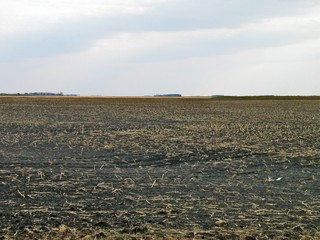
We left the lakes and forests of Ontario and shortly, within a few miles of the Manitoba border, were travelling on the flat prairie as we approached Winnipeg. It was obvious that spring planting was under way, although we were told that they were about 3 weeks late because of the cold weather.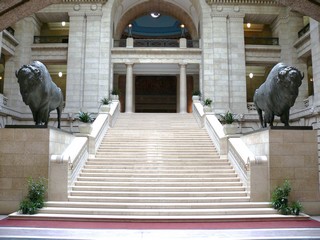
In Winnipeg we visited the Manitoba Provincial Legislature building which was officially opened in 1920. It is beautiful, constructed principally from Tyndall limestone, quarried just northeast of Winnipeg. On entering the building we were impressed with the grand staircase, flanked by two bison. In warmer climates, we saw these huge staircases on the outside of such buildings. This interior one seems very practical and sensible given Winnipeg's winters.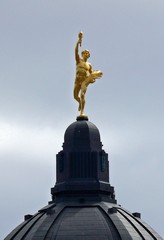
One of the most recognizable features of the Manitoba Legislature building is the “Golden Boy” that graces the building’s dome.
Originally made of bronze, he is now gilded with 23.5 carat gold leaf. He measures 16 feet from toe to torch tip and weighs 10,000 pounds. The figure reaches just over 223 feet above ground.
The statue was sculpted in Paris, France in 1918 and escaped damage when the foundry was partially destroyed by bombs. It was then placed aboard a French ship bound for the U.S. but the ship was commandeered for war purposes. For the remainder of the War, the Golden Boy lay in the hold of the ship, travelling thousands of kilometers, in constant danger. It arrived in North America at the conclusion of the War, was shipped by rail to Winnipeg and was hoisted into position in 1919.
A guided tour of the Canadian Mint completed our sightseeing in Winnipeg this trip. The Winnipeg Mint produces all of the Canadian coins in general circulation while Ottawa produces the bills and proof sets. As well, this facility produces coins for over 60 countries worldwide. The volume of coins is outstanding – 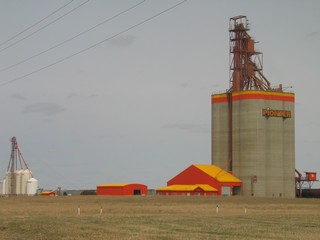 its high speed presses can strike 750 coins per minute
its high speed presses can strike 750 coins per minute
Dinner with friends, Rob & Shannon, and a contribution to the Winnipeg economy at the Casino, completed this visit.
We left the following morning, May 10th travelling the Trans Canada Highway. At Brandon, we started into new territory. This far we had driven these roads on our first RV trip west in 2005. (See May and Sept 2005)
The old style wooden grain elevators are being replaced with the new ones as seen here.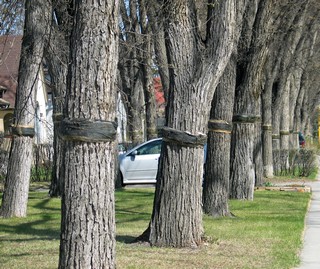
In Regina, as in Winnipeg, we saw many trees with banding on them. The trees all appear to be elm and we presume that it has to do with the prevention of Dutch Elm Disease.
We visited the RCMP Heritage Centre at the entrance to the RCMP Academy. The Academy is where all RCMP officers receive their training. It is an excellent account from the origin of the RCMP to todays high-tech police force.
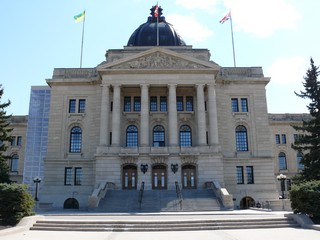 We also took a tour of the Legislative Building which was completed in 1912.
We also took a tour of the Legislative Building which was completed in 1912.
The building is surrounded by 165 acres of landscaped grounds and seemed a very people-friendly place. There were families out walking, teenagers playing ball and throwing frisbees. There was even a band playing at the side of the building with quite a crowd gathered.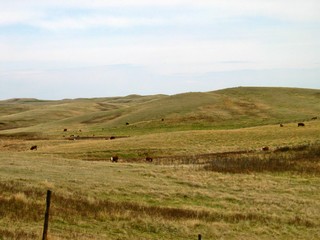
The following day we were surprised to find rolling hills and cattle as we travelled west from Regina toward Medicine Hat. Both of us had expected to find a continuation of the flat grain fields.
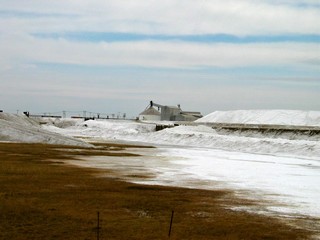 We were even more surprised to find salt – salt ponds, salt lakes, salt beside the road and even salt piles that looked like snow.
We were even more surprised to find salt – salt ponds, salt lakes, salt beside the road and even salt piles that looked like snow.
The area around Chaplin, SK encompassing some 15,000 acres of inland saline water is a haven for more than 30 species of birds that feast on the brine shrimp that are found in the salty, shallow water.
The Trans Canada Highway bypasses many of the small towns through the prairies. This has caused severe economic loss but many of the towns have tried to overcome some of the problem, by erecting advertising signs along the highway before the entrance to the community from the TCH. It actually is quite effective as you know in reasonable detail what businesses you can expect if you leave the highway for the town.
You can note above that we had returned to the flat land again – and it was only about 30 minutes past the rolling hills.
We met RV friends, George and Arlene from Vancouver Island, in Medicine Hat, AB. They are heading to the east this year and we are heading west – we both worked our schedules so we could have dinner together as we crossed paths.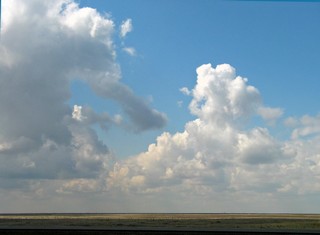
Shortly after we left Medicine Hat, we turned off the Trans Canada Highway that we had followed since southern Ontario.
As we headed north toward Edmonton, we stopped to admire the beautiful clouds. Here the prairies go on forever.
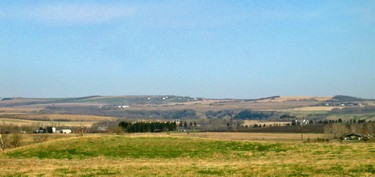 By the time we reached the Edmonton area the land, of more mixed agricultural and grassland, was much more in evidence
By the time we reached the Edmonton area the land, of more mixed agricultural and grassland, was much more in evidence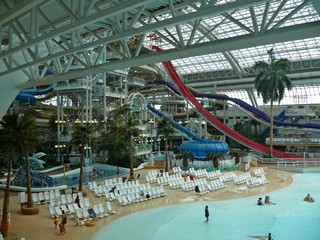 No visit to Edmonton would be complete without a trip to West Edmonton Mall, one of the worlds largest shopping centres. There are more than 800 stores and services, 19 movie theaters, more than 100 eateries and nine major theme attractions.
No visit to Edmonton would be complete without a trip to West Edmonton Mall, one of the worlds largest shopping centres. There are more than 800 stores and services, 19 movie theaters, more than 100 eateries and nine major theme attractions.
This is the World Waterpark. It offers 5 acres of indoor fun, including a giant wave pool. There are also two mini golf courses, an NHL ice rink, a recreation centre including bowling and a casino. Talk about a full service mall.
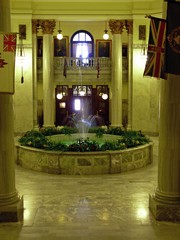
As we try to do with each capital of a province or state, we visited the Alberta Legislature buildings.
Another beautiful building, completed in 1912, built of granite and sandstone, with an interior of marble.
One of the interesting tidbits imparted by our guide: on the second floor balcony, the sound of this fountain is concentrated in one spot and it seems that water is pouring on the ceiling directly above your head.
We spent one of our evenings with Barnaby’s parents, Liz and Mike and our second evening with friends, Deborah, George and Don. We also did some shopping to stock up on items that we thought might be in short supply as we head into the Territories.
I guess this was where our trip to the north actually started. We left Edmonton about 9:30 AM on Friday May 16th. The weather was great, the sun was shining, we had a full tank of diesel and we were on our way.
We’ll write more down (actually UP) the road.
Bernie & Ross
Posted by Bernice at 07:06 PM | Comments (4)
May 08, 2008
Home in April 2008 - then on the road again
April was a VERY busy month. As we were only going to be home in Ontario for about 30 days before we head out again, we had many things to do.
We are heading to the northwest – Northwest Territories, Yukon and Alaska to start with. We’ll be back into Alberta probably in September then down through the western states of Montana, Idaho, Wyoming, Colorado and Utah. Finally, we expect to spend most of next winter in Mexico and then back home in April of 2009.
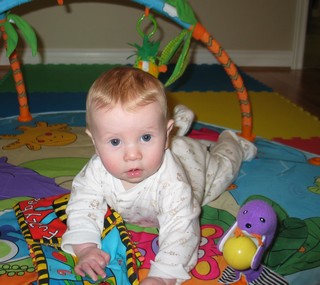
First priority, of course, when we got home was seeing Timothy, who is now about 6 months old. It goes without saying that we were happy to see Michelle and Barnaby, but they don’t change much at their ages. We had seen Timothy mid January and it is amazing how little ones develop in such a short time.
Early in April we went to the Ministry of Health, to arrange for an approved long absence from Ontario. For those of you who don’t live in the province, Ontario requires that you are resident for 153 days (five months) in any 12 month period in order to maintain your Health Insurance. That doesn’t mean consecutive days, just 153 in total. However, as people like to travel, that may be quite restricting, so twice (in your lifetime) you can apply to the Ministry for an exemption to this requirement for a one year period. These periods can be taken separately or together to give you a two year exemption.
It is important to have this approval as the additional travel insurance most people obtain when going out of country is dependent on your eligibility for your provincial coverage.
We needed to visit doctors and dentists, get the truck in for a complete go-over, visit with many friends, some as far away as Brockville, visit with family, take the trailer in for a complete go-over, get our taxes sent in and do all the multitude of things that need to be looked after when you are going to be away from your home base for a year.
So – we’re off.
We left on Saturday, May 3rd and last night, May 6th, were in Kenora. We haven’t wasted any time travelling Highway 11, then 11/17 across the top of Lake Superior. We were through here in May 2005 so have already seen many of the sights.
Here are a few pictures
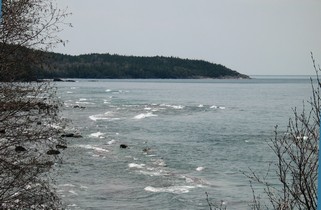
The Lake Superior shore line is long, generally uninhabited, rocky and cold. Then, unexpectedly we would pass through a very sandy area.
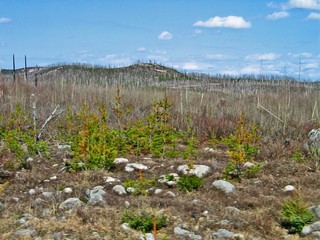
There was one long stretch where there had been a huge fire a number of years ago. New trees are growing again.
It was interesting to see how the road actually acted as a fire break.
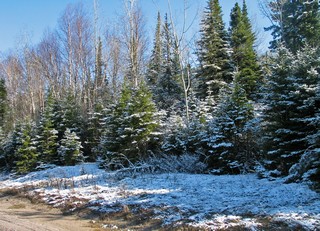
It had rained a little over Sunday night where we were, so when we reached some of the higher elevations on Monday morning, we were treated to beautiful scenes with the snow on the trees.
Fortunately it was only on the side of the road – the pavement was dry.
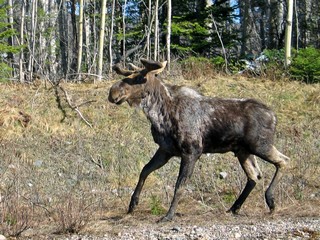
As we reached the brow of one of the hills this moose was on the side of the road. It ran along beside us for a couple of hundred feet before it stopped.
Can we ever understand how your vehicle would be demolished should you hit one!
They are massive.
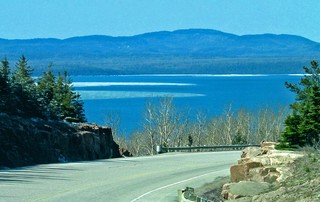
All along the north shore there are rock cuts, huge hills and blue lakes – many with ice still in them.
But it’s beautiful!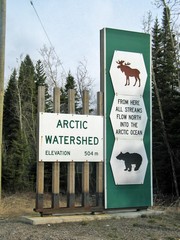
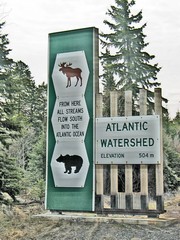
Just north west of Thunder Bay is where the waters of eastern North America split.
South of this point all waters run to the Atlantic. North of it all waters run to the Arctic.
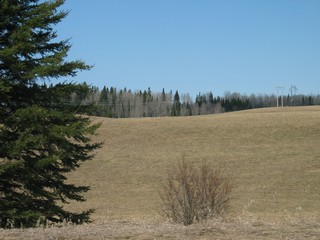
We were surprised at the amount of agricultural land around Dryden. After the rocks of Superior, I guess we had just expected it to continue. Not so – obviously a fertile pocket in the north.
It was another long drive to the campground in Kenora, but the next segment is only about 250 kilometers to Winnipeg. We’ll stay there a couple of days before heading out again.
Bernie & Ross
Posted by Bernice at 10:14 AM | Comments (1)